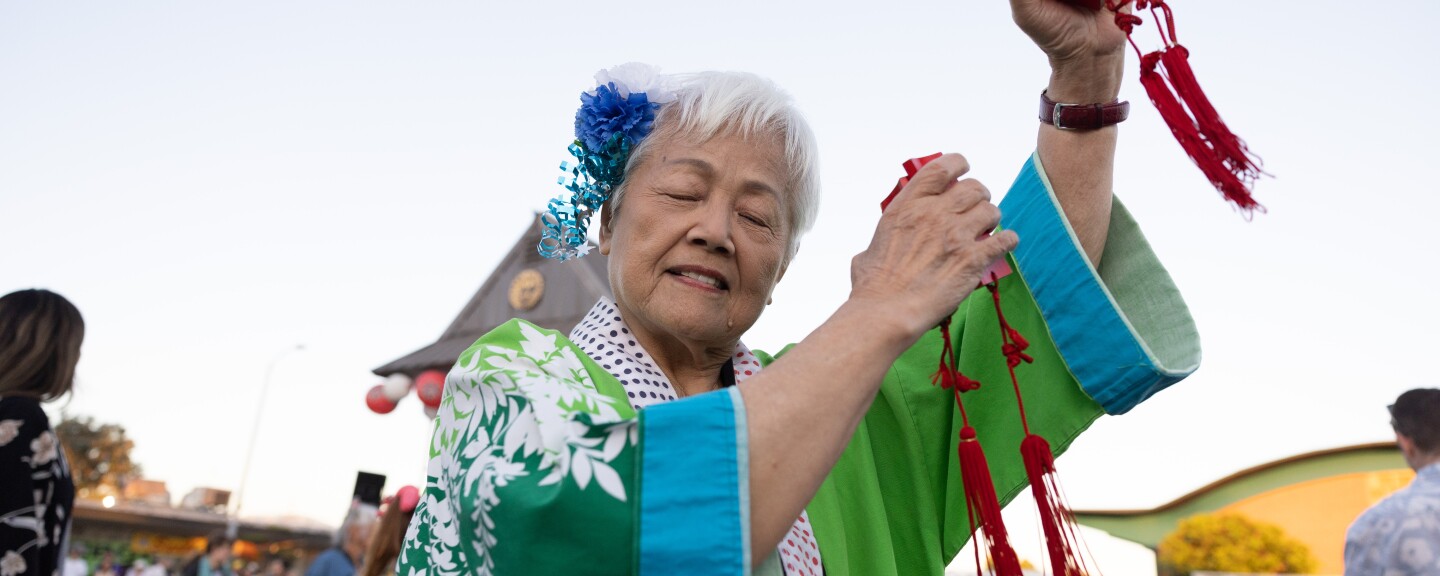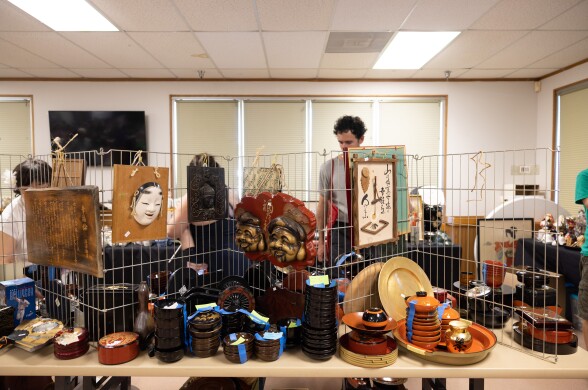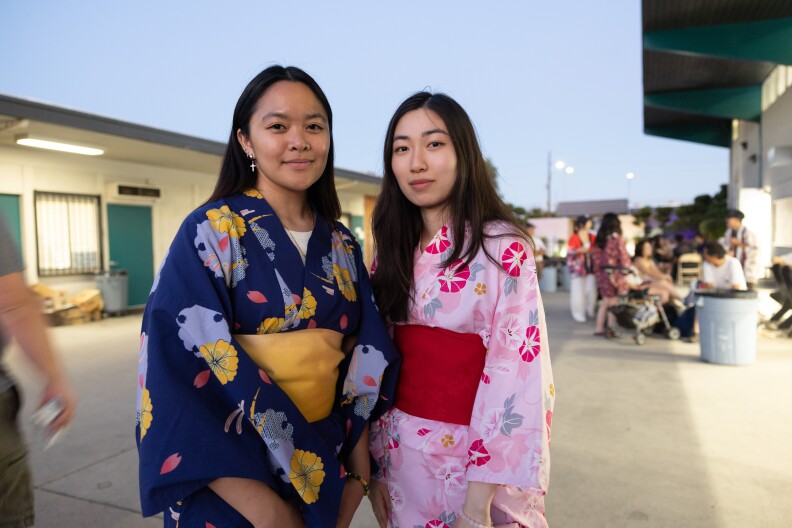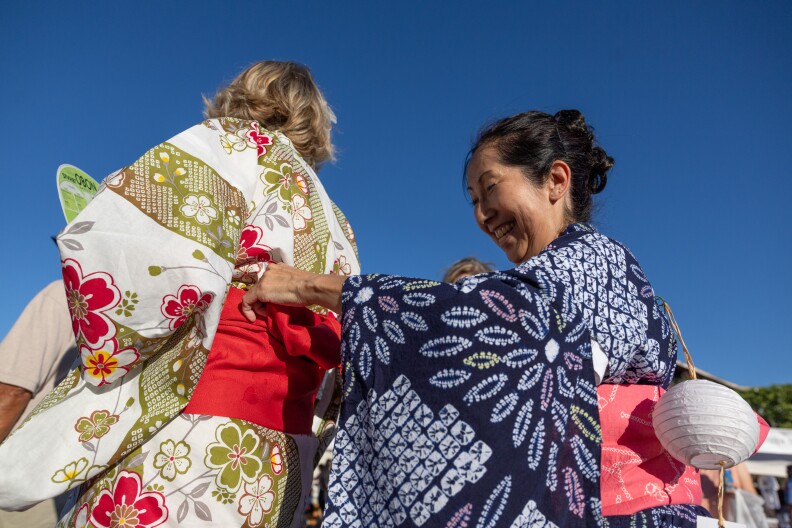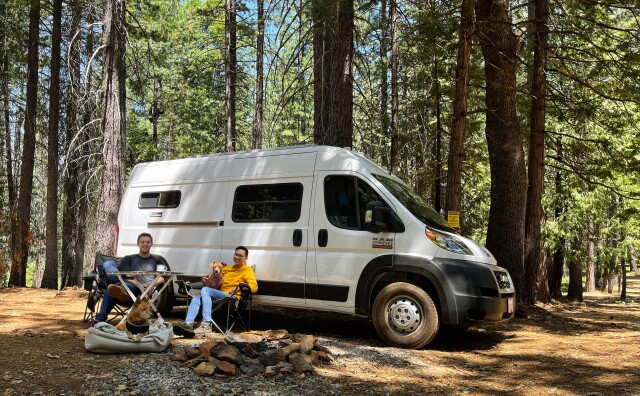Summer weekends at SoCal Japanese Buddhist temples fill with carnival games, Japanese food and dancing as people of all generations come together to celebrate Obon, a joyous holiday dedicated to remembering and honoring ancestors.
Growing up Japanese American, attending an Obon festival evokes instant nostalgia — I remember being a kid eating peanut butter mochi and shaved ice during breaks between dancing. Learn more about Obon.
-
- Obon — one of SoCal’s biggest Japanese American celebrations — is a joyous summer holiday dedicated to remembering and honoring ancestors. It’s a bit like the Japanese version of Día de Muertos, with a distinctly Japanese American twist.
-
- Festivals take place at temples and community centers from June to August and include carnival games, home-cooked food, and traditional Japanese dancing.
-
- All are welcome. Learn more about the history and find one near you.
I attended an Obon festival in the San Fernando Valley, hosted over two days by the San Fernando Valley Hongwanji Buddhist Temple at the San Fernando Valley Japanese American Community Center next door. What follows is a visual and audio tour of the weekend, from the chopping veggies to dancing at sunset.
For audio listeners: I recorded part of the audio story using binaural sound, so grab a pair of headphones for the full experience.
The setup starts at dawn

Preparations for the San Fernando Valley Obon Festival start early. For temple members organizing the festival, Obon is an all-day affair, where everyone pitches in.
Some people arrive as early as 6 a.m. to start preparing food. Some won’t leave until clean up is done around 11 p.m.
By 10 a.m., the room is buzzing with people helping out with food prep. Long tables fill a room where people chop onions and lettuce for soups and salads and slice oranges for teriyaki beef plates. San Fernando Valley Hongwanji Buddhist Temple president Linnae McKeever weaves between the assembly lines offering instruction, answering questions, and directing volunteers to their stations.
“We're all atoms in motion,” says McKeever. “We have to do food prep for thousands of people that are coming in.”

In another room, Kari Nishimura adds bright pink ginger to boxes of chirashi.
“Honestly, I grew up here,” says Nishimura. “My grandparents and my great grandparents were actually the people who built our temple.”
She notes that Obon is often a reunion, where she runs into friends she has known since middle or high school. She also now sees the younger generation of her nieces and nephews enjoying the same traditions she did growing up.
You can't help but feel nostalgic and just be in a good mood.
At another table, a spam musubi assembly line is in full swing. Four temple members press rice and spam into large rectangular molds. They cut each rectangle diagonally so that when it’s arranged in the container, it looks like a heart. “So that when people get it, they can see it was made with love!” says Nishimura.
“We are so busy with our own Obon that we can't dance at ours, usually,” jokes Priscilla Mui, who is slicing and bagging oranges. “So we go to all the other ones so that we can dance.”
Obon festivals in Southern California are staggered on different weekends throughout the summer to allow people to attend multiple festivals a year. Mui says she usually tries to go to a handful of festivals each year. One year she went to six or seven.
All of the work that temple and community members put into each Obon festival is something you can feel right when you walk in. There’s a warmth to the food and the laughter of friends reuniting that surrounds you.
“You don't have to be a Buddhist, you don't have to be Japanese, to come out to an Obon festival and enjoy it,” says Jason Fenton, San Fernando Valley Hongwanji Buddhist temple first vice president. “Our community is made up of so many diverse religions and cultures. And building friendships and understanding is the key to what makes a community thrive.
So much food! Teriyaki beef, udon, Okinawan andagi, and more
In the late afternoon, the festivities begin. People slowly start to trickle in and set up camping chairs to save their spot close to the dancing circle, drawn with chalk around the perimeter of the festival. It’s the middle of summer in the San Fernando Valley and the heat is just starting to fade into that thick warmth of early evening.
When you enter, the first thing that hits you is the smell of teriyaki beef. It’s the hottest spot in the festival, with San Fernando Athletics parents at the grill and students serving up platters.

There are home-cooked foods everywhere. Many of the foods you see at Obon festivals are Japanese American fare, like spam musubi, Okinawan sata andagi, and chili rice.
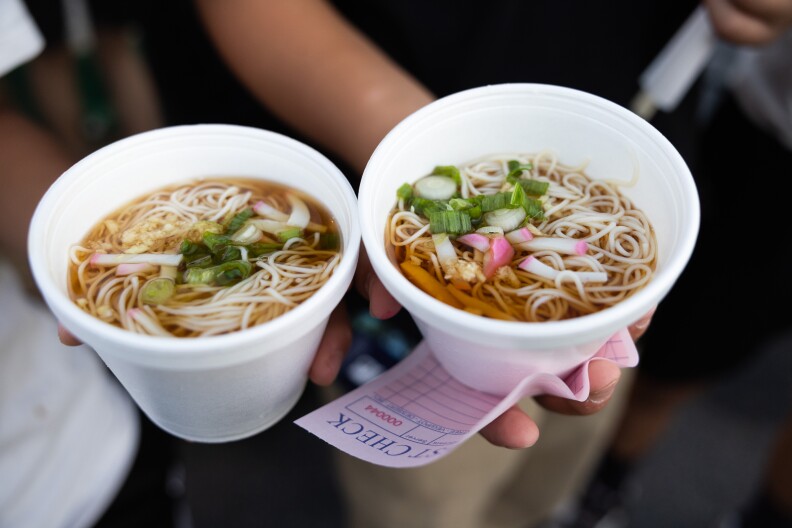
For the kids: Games, activities, and tradition
For families, one highlight of the festival is the games. Various temple and community center groups run the booths, which line the perimeter of the festival. Kids walk up to try their hand at winning prizes by tossing ping pong balls into glass balls, fishing for colorful wooden fish, and throwing metal rings around coins on a table. Many groups have been running these games at the festival for years, passing on the know-how to the next generation of families each year.

For many Japanese Americans of my generation, Obon festivals are a chance for fun memories and also, a little bit of tradition.
“We've been coming here since my oldest daughter was four. That's how we actually started having them come to the Japanese school here,” says parent Yurika Yamaguchi, adding that as an educator, she knows it’s important for her kids to know their culture.
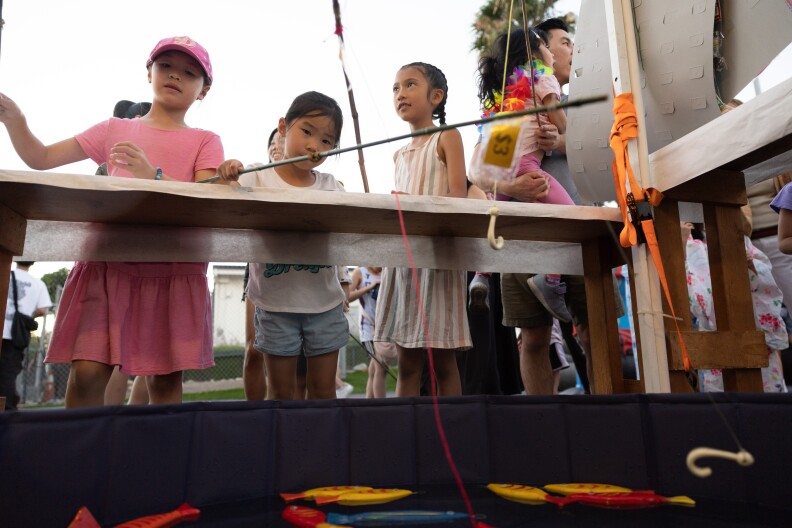
“Our kids are fifth generation. Over time, obviously, you lose tradition and culture,” says parent Justin Yoshizawa, who is working the teriyaki and shumai booth this year at the festival. “This is one of those events every year that we do consistently that helps remind them of their culture.”
This is one of those events every year that helps remind [our kids] of their culture
One place to escape the heat is in the bingo room at the San Fernando Valley Japanese American Community Center. The hall is packed with tables, where people try their luck at bingo while they eat their food.

The perimeter of the hall is lined with crafts and secondhand Japanese tableware and artwork for sale.

The festival also showcases performances from groups at the San Fernando Valley Japanese American Community Center, like ukulele and taiko drumming. Many friends and family cheer on performers from camping chairs they’ve brought from home.
Dancing to honor loved ones passed

As the sun begins to set, the main event begins: Bon Odori, or traditional Japanese folk dancing, with the whole crowd participating.
“I want to begin to invite people to come to the circle,” says MC and temple member Traci Ishigo. “Are you ready to dance?”
She reminds the crowd that no experience is necessary and that most folks are also just remembering the moves like they are.
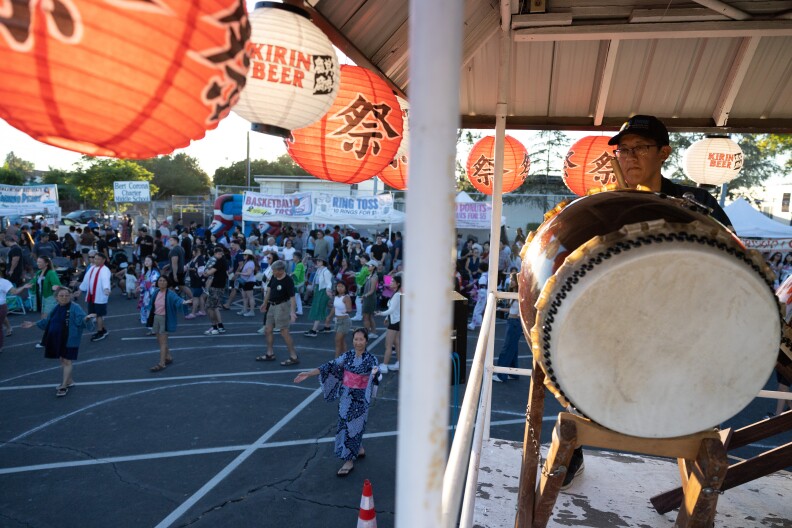
Festival-goers, young and old, in yukata and happi coats, form a huge circle around the yagura, a central, elevated platform decorated with paper lanterns.
As the folk music blasts from the speakers, taiko drummers keep a steady rhythm. Don. Kara-kara. Don. Kara-kara. Don. And the crowd of strangers, most watching the instructors and their neighbors for cues, slowly begins to move in step, at first unsure, then slowly with more confidence.
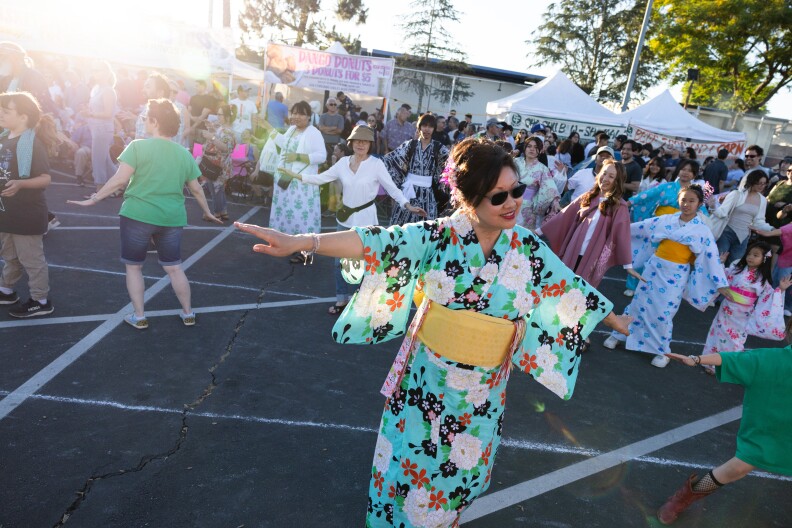
It’s hard to explain the feeling of dancing in unison with a large group of joyful strangers. Each dance tells a story in a handful of simple, repetitive movements: Fishermen casting nets into the sea, coal miners pushing carts, hands to forehead to wipe away sweat. It’s like honoring something ancient and bringing it into the present.

“Obon is a time to remember your ancestors and thank them for the life you have now,” says Reverend Yukari Torii. She says that in Japan, celebrating Obon is much more akin to Thanksgiving, where people travel home to spend time with family members.
In the U.S., as immigrants could not return to their hometowns, they instead took the opportunity to gather at Buddhist temples (or churches, as they’re often called here), which became hubs for Japanese American culture and community.
-
- Credit often goes to Reverend Yoshio Iwanaga for introducing Bon Odori on the mainland in 1930. As a music instructor, he infused into the celebrations music and dances from all over Japan, which are now central to Japanese American Obon celebrations.
-
- During World War II, when the U.S. government incarcerated Japanese Americans, Obon celebrations didn’t stop. People celebrated in camp. Emily Anderson, historian and curator at the Japanese American National Museum, says: “There's something really powerful to me that despite all the circumstances, they still celebrated.”
-
- See photos and learn more about Obon’s history.
Joanne Tokeshi is the lead Obon dance instructor for the temple and she coordinated this year’s dances. Though every year the Buddhist Churches of America Southern District selects a short list of songs that become the standard dances at all of the festivals, each temple adds their own favorites. She always adds one pop song into the mix. This year dancers apply the moves from the traditional dance Itsu Tatsu Ichi to Dua Lipa’s Dance the Night.
Tokeshi has a background in Japanese Odori, which made her a natural fit to take the lead on her temple’s Bon Odori lineup. She has memories of three generations of her family dancing Bon Odori — her mom, her, and her daughter.
“I did lose my mom a couple of years ago,” says Tokeshi. “So, Obon became even more special for me to remember her — and celebrate with joy.”
I did lose my mom a couple of years ago. So, Obon became even more special for me to remember her — and celebrate with joy.
Jason Fenton says that some of his most joyful memories have been watching his children grow up and dance Bon Odori. One song, Gassho Ondo, features a moment where dancers bow to each other in thanks.
“And at that point in the song, my daughter turned to my wife and they bowed to each other. To me, that was beautiful,” he said.

Magic hour at the festival
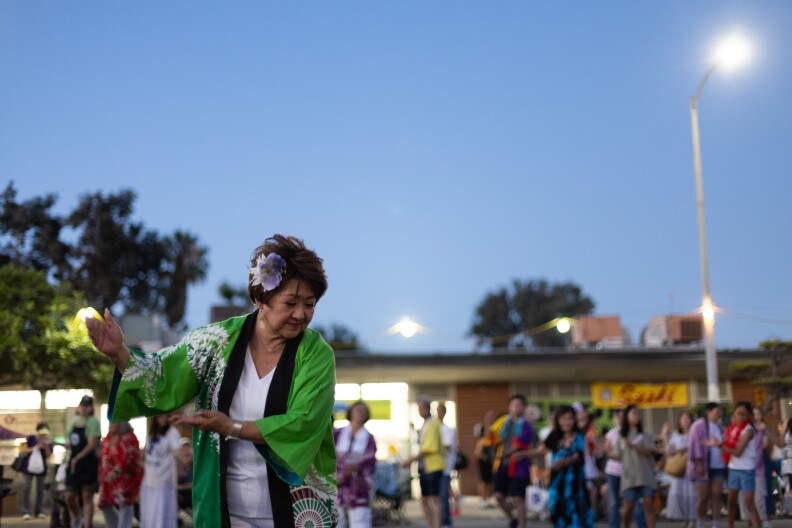
After the sun goes down, the dancing continues. The festival takes on a more relaxed and comfortable energy. People go back for seconds of their favorite food or look for dessert. Lights illuminate the booths of food and games, with the steady drumming of taiko to music in the background.

Inside the hall, blackout Bingo is in full swing, and things are picking up. At a desk on the stage, temple president Linnae McKeever counts the cash coming in from Bingo tickets. Bingo host Jean-Paul deGuzman makes a pitch to the audience to buy tickets for last call for Bingo tickets and a flurry of hands go up in the crowd. It’s like the attendees don’t want the night to end.

My two kids don’t want the night to end either. They wander around looking for one last game to play, one last sweet treat to eat. It’s these little moments that I hope they’ll remember as they grow.

This year marks the San Fernando Valley Hongwanji Buddhist Temple's 103rd anniversary. Many of the Japanese American Buddhist temples boast similarly long histories. McKeever hopes that this community, and celebrations like Obon, continue to carry on into the future. “I'm hoping that [the next generation] will pick up where we left off and they'll carry on that strong tradition,” she says.
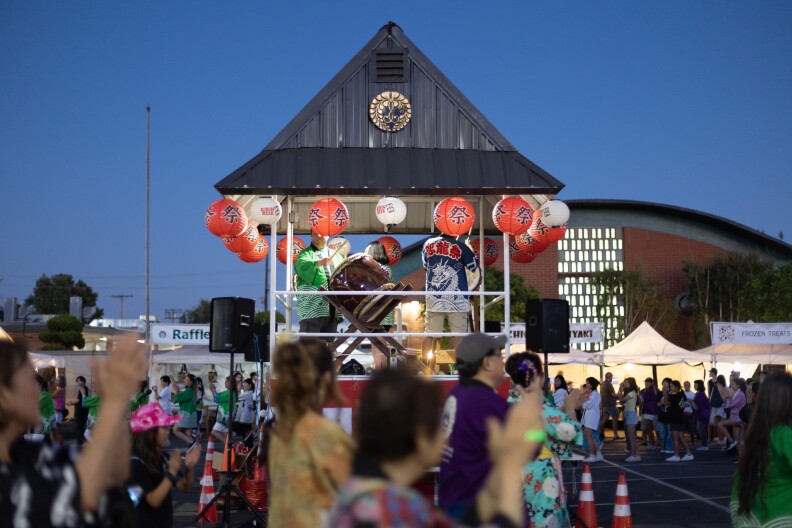
Diane Hope provided coaching and feedback on the audio story.

